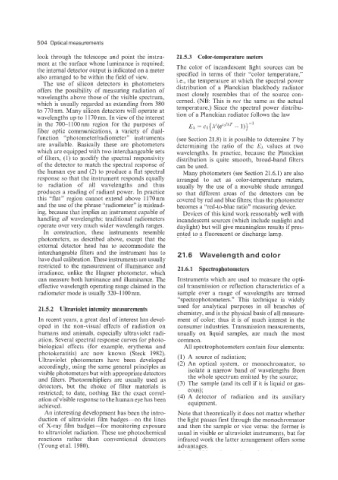Page 521 - Instrumentation Reference Book 3E
P. 521
504 Optical measurements
look through the telescope and point the instru- 21.5.3 Color-temperature meters
ment at the surface whose lumiiiance is required; The color of incandescent light sources can be
the internal detector output is indicated on a meter specified in terms of their “color temperature,”
also arranged to be within the field of view. Le., the temperature at which the spectral power
The use of silicon detectors in photometers
offers the possibility of measuring radiation of distribution of a Planckian blackbody radiator
most closely resembles that of the source con-
wavelengths above those of the visible spectrum,
which is usually regarded as extending from 380 cerned. (NB: This is not the same as the actual
to 770 nm. Many silicon detectors will operate at temperature.) Since the spectral power distribu-
tion of a Planckian radiator follows the law
mavelengths up to 1170 inn. In view of the interest
in the 700-1100nm region for the purposes of
fiber optic communications. a variety of dual-
function “photonieter/radiometer” instruments (see Section 21.8) it is possible to determine T by
are available. Basically these are photometers determining the ratio of the E,\ values at two
which are equipped with two interchangeable sets wavelengths. In practice, because the Planckian
of filters, (1) to modify the spectral responsivity distribution is quite smooth, broad-band filters
of the detector to match the spectral response of can be used.
the human eye and (2) to produce a flat spectral Many photometers (see Section 21.6.1) are also
response so that the instrument responds equally arranged to act as color-temperature meters.
to radiation of all wavelengths and thus usually by the use of a movable shade arranged
produces a reading of radiant power. In practice so that different areas of the detectors can be
this “flat” region cannot extend above 1170 nm covered by red and blue filters; thus the photometer
and the use of the phrase “radiometer” is mislead- becomes a “red-to-blue ratio” measuring device.
ing. because that implies an instrument capable of Devices of this kind work reasonably well with
handling all wavelengths; traditional radiometers incandescent sources (which include sunlight and
operate over very much wider wavelength ranges. daylight) but will give meaningless results if pres-
In construction, these instruments resemble ented to a fluorescent or discharge lamp.
photometers, as described above, except that the
external detector head has to acconmodate the
interchangeable filters and the instrument has to 21.6 Wavelength and cofor
have dual calibration. These instruments are usually
restricted to the measurement of illumnance and 21.6.1 Spectrophotometers
irradiance. unlike the Hagner photometer, which
can measure both luminance and illuminance. The Instruments which are used to measure the opti-
effective wavelength operating range claimed in the cal transmission or reflection characteristics of a
radiometer mode is usually 320-1 100 nm. sample over a range of wavelengths are termed
“spectrophotometers.” This technique is widely
21.5.2 Ultraviolet intensity measurements used for analytical purposes in all branches of
chemistry, and is the physical basis of all measure-
In recent years, a great deal of interest has devel- ment of color; thus it is of much interest in the
oped in the non-visual effects of radiation on consumer industries. Transrmssion measurements,
humans and animals, especially ultraviolet radi- usually on liquid samples, are much the most
ation. Several spectral response curves for photo- common.
biological effects (for example, erythema and All spectrophotometers contain four elements:
photokeratitis) are now known (Steck 1982). (1) A source of radiation;
Ultraviolet photometers have been developed (2) An optical system. or monochromator, to
accordingly, using the same general principles as
visible photometers but with appropriate detectors isolate a narrow band of wavelengths from
the whole spectrum emitted by the source;
and filters. Photomultipliers are usually used as (3) The sample (and its cell if it is liquid or gas-
detectors, but the choice of filter materials is
restricted; to date, nothing like the exact correl- eous);
ation of visible response to the hunian eye has been (4) A detector of radiation and its auxiliary
achieved. equipment .
An interesting development has been the intro- Note that theoretically it does not matter whether
duction of ultraviolet film badges-on the lines the light passes first through the monochromator
of X-ray film badges-for monitoring exposure and then the sample or vice versa: the former is
to ultraviolet radiation. These use photochemical usual in visible or ultraviolet instruments. but for
reactions rather than conventional dctectors infrared work the latter arrangement offers some
(Young et al. 1980). advantages.

